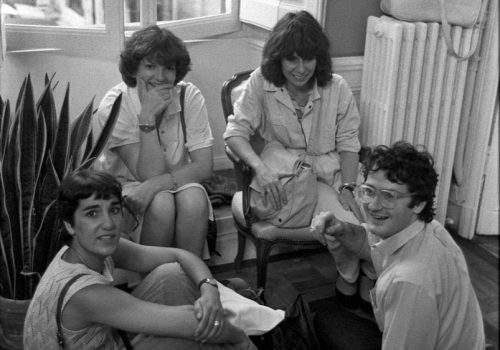In Arles, where are the Alyscamps.
Today, all the summers merge in my mind. I can no longer put years to memories.
I remember the first year, the near-empty amphitheatre, the sense of sharing a silence, a secret. Photography wasn’t for sale. Images were traded for words.
I remember Ralph Gibson on the no-textiles beach, and his bikini-clad nymphs glistening with seawater.
I remember Robert Mapplethorpe sitting at a long table by the pool. It was 35 degrees celsius. He was wearing a leather jacket, leather pants, and biker’s boots with silver buckles. His sweat dripped from his brows into his eyes; stoically he didn’t flinch.
I remember André Kertesz, his sweet blend of French and English and his weakness for young blondes.
I remember Willy Ronis, with his faun’s pointed head, recounting his paragliding flights.
Of all the dinners (why?), I remember one at Le Poisson-Banane with a radiant Martine Voyeux, Jean-Claude Loiseau, Danielle Digne, Guy Mandery with his foot in plaster, and a Polish girlfriend who’s now dead, Urszula Czartoryska, with her slightly shy smile and princess’s airs and graces.
I remember the first time I saw Anders Petersen’s “Café Lemnitz” photos and those by Christer Stromhölm. It felt like meeting soulmates.
Besides the photos of injured birds, of reeds and brushwood, of medieval tombs, I remember a collage by Max Ernst in Lucien Clergue’s house on Rue Aristide Briand: “A Lucien, génie des étangs” (“To Lucien, genius of the lagoons”).
I remember Henri Cartier-Bresson, who told me about the Spanish Civil War: “I had typhus and large pustules on my head, and when I filmed the wounded, my skull was like theirs, wrapped in a huge bandage.”
I remember how happy I could be, arriving in Arles, but sometimes wracked with anxiety: the city felt like some confined place where you could not escape other people or your own social surface.
I remember betting with some girlfriends that we would take off our T-shirts for the duration of a screening at the amphitheatre. We did it.
I remember Lorenzo Merlo, sitting in the Hôtel de l’Arlatan courtyard, reading comics and laughing to himself.
I remember the immense hope of the young photographers queuing in the courtyard to show their portfolios; the power they imagined I had; and having to disappoint them.
I remember sleeping in the back of the truck of Pierre Mercier, a photographer from Lille, because Le Matin gave me 50 francs expenses a day.
But also my joy at dictating an article down the phone and buying the newspaper on the stand the next day: not yet thirty years old, I still imagined opinions mattered.
I remember the beauty of Maryse Cordesse’s garden, the white tablecloths, the scent of figs, and orange sorbets.
I remember walking towards the amphitheatre through a tunnel smelling of saltpetre, between rows of candles, on a bed of rose petals.
I remember drives down to Arles in Viviane Esders’ sports car (it was red, of course), with the top down; reaching the Provencal autoroute with Cézanne’s purple mountains on the horizon. July. The smell of lavender and dust.
I remember the Tziganes’ horses in the setting sun, walking very slowly in single file on the sand at Saintes-Maries de la Mer, as if ridden by ghosts.
I remember my first car, dented and battered: a Volkswagen, photographed on the beach by Philippe Salaün.
I remember my huge sadness when, on returning from the United States in 2002, the presentation of Pixelpress was interrupted by whistling, stamping feet and screams of “Capitalists!” and “That’s enough 9-11!” (no one is a prophet in their own land).
But most of all, I’m amazed I remember so little. All my memories are doubtless in the articles I filed for newspapers.
Photographs are for remembering.
Perhaps one writes to forget.
Archives of the Eye of Photography – Carole Naggar
NYC, 22 April 2009
















